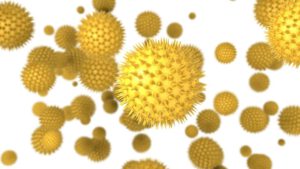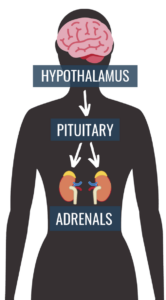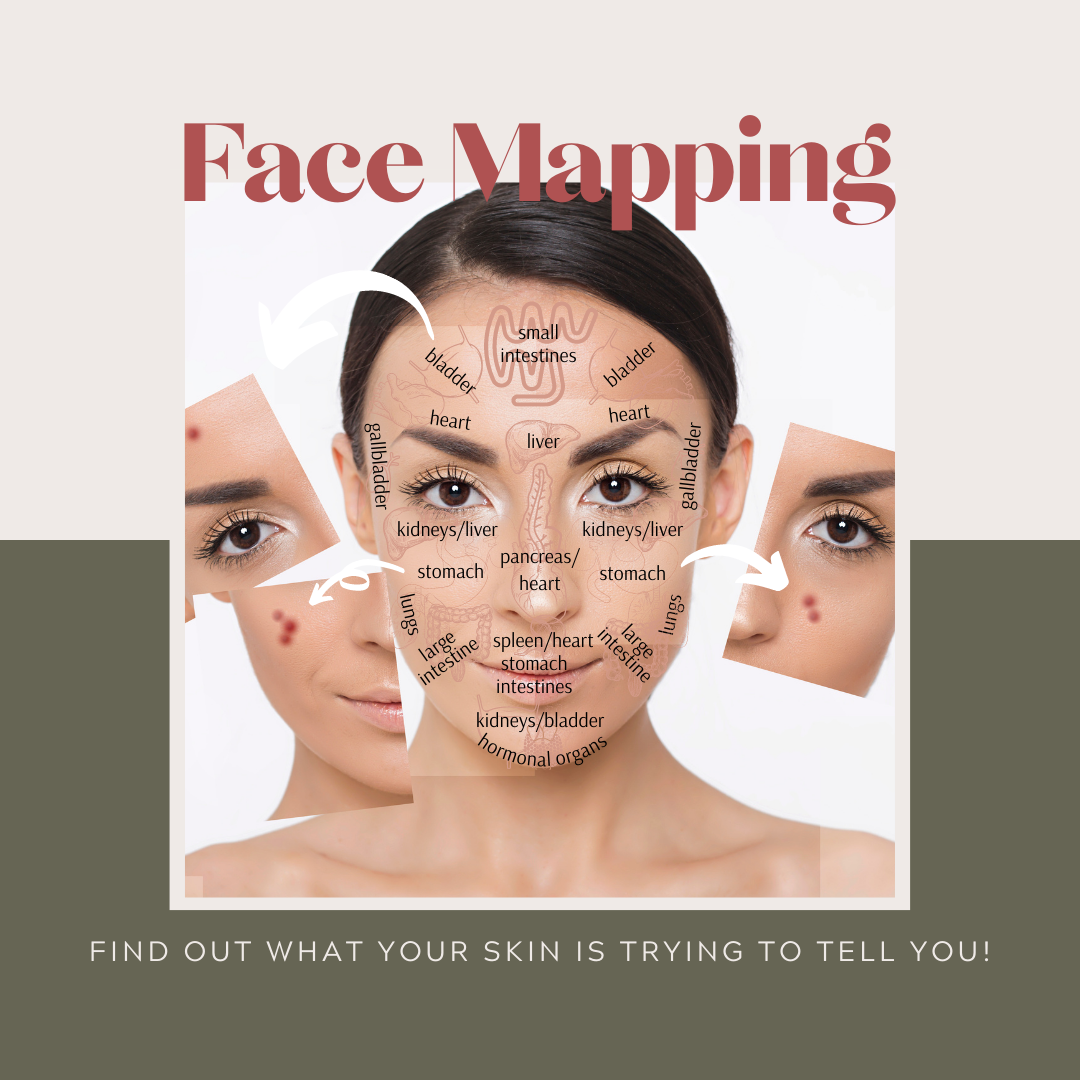Stuffy noses, constant sneezing, itchy eyes and drainage!
Sounds like “seasonal” allergies. But, what exactly is at the root of these symptoms that come with the change of the seasons and what can we do to support our bodies’ natural responses?
What are allergies?
When we understand what’s happening during allergy attacks, treating them naturally seems like common sense. First, picture a grain of pollen — it looks something like a spiny sea urchin.

Now imagine this prickly invader entering the nasal passages and latching onto soft mucous membranes. These mucous membranes line our bronchial and nasal passages and contain immune cells, called mast cells, which are loaded with histamines.
Receptors sit on top of these mast cells, and when an allergen trigger — such
as pollen, mold or pet dander — lands on top of the receptor, it alerts the mast
cells, which respond by releasing histamine and other chemicals. The
histamine initiates a series of reactions designed to help the body get rid of the
intruder, including sneezing, watery eyes and itching. For some people,
particularly those with asthma, this reaction may also include swelling in the bronchial tubes that makes it difficult to breathe.
Most allergy “medications” attempt to block the immune system response your body instigates to get rid of the allergen. But, does it not make more sense to strengthen the body’s defenses before it goes into attack mode? Many of the natural remedies discussed in this post are designed to do just that!
Supporting the Body
Although numerous “medications” are available to treat allergy symptoms, a large percentage of the 26 million Americans who suffer from seasonal allergies agree that their symptom relief is often incomplete, and they often have to rely on multiple medications to control their sniffling, sneezing and itching, wheezing, and watery eyes. Additionally, nearly a third of allergy patients think their medications don’t work at all. Pharmaceutical remedies are often expensive and frequently come with unwanted side effects, such as drowsiness, dry mouth, nasal irritation, nose bleeds, and a kind of “mental fog or disconnect,” — more on this to follow.
Before turning to pharmaceuticals for allergy relief, start by supporting the main systems in your body that will fight allergens – the gut, kidneys, & liver!
“We see good allergy relief in patients when we work on the liver and gut as well.”
– Crystal, Functional Medicine Provider
Learn more about how a Functional Medicine Pathway can optimize the health of your gut – as well as your liver, kidneys, and other vital organ systems!
Contact us
While supporting your body’s internal systems directly, you can externally decrease your exposure to unwanted allergens through some practical lifestyle choices:
- Flush sinus passages after high exposure to allergens such as pollens, dust, and molds like after mowing the yard, raking leaves, a windy day, etc. Products such as NETI POTS provide a simple way of rinsing away pollen grains in the nose and ease congestion from allergies and the common cold.
Studies have found that nasal flushing is an effective way to treat seasonal allergies in children, and markedly reduced their use of antihistamines.
- Avoid foods you are sensitive to (allergy and food sensitivity testing can be done to determine these). Common foods with high allergens include gluten, dairy, foods with high amounts of pesticides or GMOs, etc.
- Keep your air clean especially in seasons with lots of commercial spraying and farming. Some practical ways to do this is to keep windows up while driving, avoid window fans as they pull allergens in, clean air vents, and using an air filter when needed.
Allergy Symptoms
Sneezing, coughing, runny nose, itchy eyes and/or skin, swelling… these are all signs of, yes, allergies, but also that your body is detoxing the pollens, dust, molds, and dander!
Instead of fighting the symptoms, rejoice that your body is working hard FOR you and not against you!
The supplements our providers suggest help support the body/detox pathways, boost the immune system and/or calm the histamine reaction if it’s overstimulated – like a bad allergy season (Southeast Missouri is a prime example of bad allergy seasons… plus, we have bad mold in the air! eek!)
Natural Allergy Support:
- Nettle – any and all forms
- Raw local honey (as close to your house as possible)
- ButterBur – herbal product in capsules
- Pulsatilla – homeopathic remedy
- Lemon, Lavender, or Peppermint Essential oils – use as directed; in deep breaths while diffused and mixed with carrier oil to be rubbed on sinus areas
- Elderberry Syrup
- PROBIOTICS &, again, working with the KIDNEYS and LIVER to support this
With all lung/sinus issues (congestion, coughs, colds/flu, croup, asthma, cancer, detox, etc.), nebulizing Colloidal Silver and/or glutathione works great!
Natural Anti-Histamines
- Nettles
- Bee Pollen
- Magnesium
- Quercetin
- Vitamin C
Natural Sinus Infection Support
- Andrographics – This is an herb from China and India. It’s a very strong anti-viral. Available from Medi Herb and Herbalist & Alchemist online. Great for sore throats and better than any over the counter medicine for sinus infections!
Many sinus infections are fungal in origin and will not respond to antibiotics for this reason as antibiotics are actually fungal-based drugs that can make the infection worse.
Our Favorite Allergy Supplements:
In addition to lifestyle practices during these seasons of higher allergens, supplements can aid the body while under high environmental stress.
Pre-season, load up on supplements such as quercetin, vitamin C, and bromelain. Some supplements we like for this are:
- D-hist
- HistaminX
- AllerMax
If sinus issues are present, try Earthley’s Sinus Saver Tincture – which is a great herbal tincture made with organic nettle leaf, elderberries, turmeric root, black pepper, and dandelion root.
For sinus infections, or if you feel one coming on, try Sinatrol!
And, for lung issues, try Mullein tea or tincture! Mullein is a very common plant and a supreme, safe, and profound respiratory tonic. It helps open the lungs, eases spasms, tightness, and cough, and soothes irritation and dryness.
Conclusion
- Allergic reactions, including allergic rhinitis and food allergies, have dramatically increased over the last several decades.
- Common hay fever symptoms can include having a stuffy nose, sinus pain, headaches, fatigue, itchy throat, watery eyes and more.
- Medications may provide some relief but usually not as well as natural remedies. Plus, they don’t solve the underlying causes.
- Treating allergies takes patience and a combination of tactics. Start now by removing foods you are sensitive to, eating foods that boost your immune system, managing stress, and incorporating supplements and complementary treatments into your routine!
Resources & Further Reading



 The gut is one of the first steps to address in healing from any illness. The gut encompasses so much – digestion and nutrient assimilation, gut microbiome, gut/brain axis, and lots of inflammation can stem from the gut!
The gut is one of the first steps to address in healing from any illness. The gut encompasses so much – digestion and nutrient assimilation, gut microbiome, gut/brain axis, and lots of inflammation can stem from the gut! Recap:
Recap:

